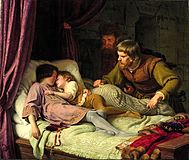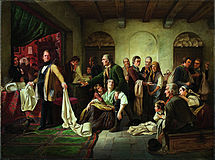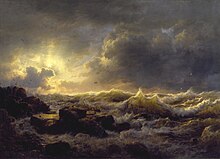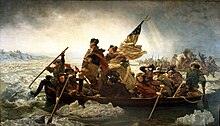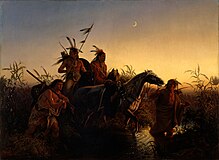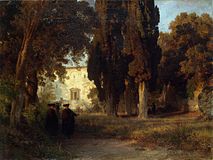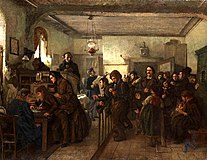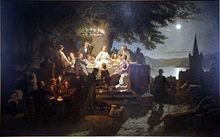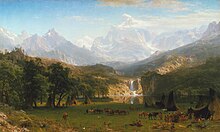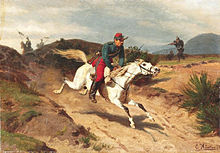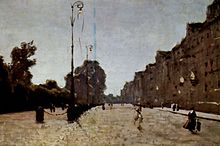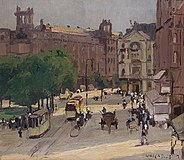Düsseldorf School of Painting

The art-historical term Düsseldorfer Malerschule , also Düsseldorfer Schule , describes a group of painters who were trained at the Royal Prussian Art Academy in Düsseldorf , especially in the 19th century - more precisely from 1819 to 1918 - and taught there and took private lessons from teachers from the Art Academy or have worked in the vicinity of the art academy.
The first academy directors Peter von Cornelius and Wilhelm von Schadow shaped the initially narrower orientation of the educational institution in the sense of the Nazarene movement and classicism . The subjects they arranged according to the classical genre hierarchy included those of mythology, Christianity, important historical subjects, and landscape painting. The trend of romanticism was noticeably spreading in Germany and found its way into the academy. Under the influence of the Vormärz , the academy's program and its artistic environment soon expanded to include romantic and other currents, so that a realistic , socially critical conception of art as well as landscape and genre painting were given more space and importance. Among the subjects and styles of the painting school are "history painting , landscape, genre and still life represented in all facets" that played a role in the " bourgeois art of the 19th century". Through reviews, publications and exhibitions, through the dissemination of the works on the international art market, in particular to London, Amsterdam, Brussels, Paris, Chicago and New York, through travels, extensive friendship and family connections as well as through the sometimes global school and professional careers of her The work of the Düsseldorf School of Painting radiated protagonists, especially in the period between 1830 and 1870, but certainly also in later decades of the 19th century. The painters trained in Düsseldorf passed on their artistic techniques, attitudes, teaching methods, subjects, topoi and discourses around the world, in other art academies and in the emerging artist colonies . In particular, landscape and genre painting in Düsseldorf was leading and style-forming for many years. The international reputation of the Düsseldorf School of Painting among artistic educational institutions in Germany was only surpassed again by the Bauhaus .
history

On March 9, 1819, the Düsseldorf Art Academy , which had experienced a significant decline in the time of the coalition wars and the Grand Duchy of Berg , by King Friedrich Wilhelm III. newly founded as the Royal Prussian Academy . This measure was not only intended as a mere act of Prussian art cultivation and educational policy, but was initiated as one of the primarily identity and domestic policy motivated measures to satisfy the Rhenish bourgeoisie in relation to the Prussian crown. The Rhineland was incorporated into Prussia as a result of the Congress of Vienna in 1815 . Among their predominantly Catholic and democratically minded population, who appeared self-confidently in the new state, which was now also anchored in West Germany, because it contributed more to its tax revenue than any other province, the feeling of being “ Must Prussia ” had spread. The distant Berlin therefore decided to counter this problem with a bundle of cultural and educational policy measures, especially in the area of university policy by establishing colleges and universities. The directors of the newly founded academy, Peter von Cornelius , director between 1819 and 1824, and above all his successor, Wilhelm von Schadow , director from 1826 to 1859, paved the way for an internationally renowned art college that also caters to young artists from abroad exerted a great attraction. In this regard, the academy was funded by the Kunstverein für die Rheinlande und Westfalen , founded in 1829 , in whose founding, besides Schadow, Karl Josef Ignatz Mosler , academy secretary and teacher of art history, played a key role. August Weber came to the academy as a student, became a professor and soon recruited students from other German cities and abroad. The basis of the "triumphant advance of the Düsseldorf School of Painting" was not least the art market , which was largely supported by the brisk demand of the rising Rhenish and Westphalian bourgeoisie. Spectacular art purchases by the high nobility, but also private art galleries such as the exhibitions by Julius Buddeus , Eduard Schulte , Bismeyer & Kraus , Paffrath , Boisserée and the American Art Union , the permanent Elberfeld-Barmer art exhibition or Johann Gottfried Bökers Düsseldorf Gallery , which started in the 1830s Years in Düsseldorf, Elberfeld, Cologne, Berlin and New York ensured constant sales and carried the reputation of the Düsseldorf School of Painting out into the world. In Düsseldorf itself, the first gallery district in the Rhineland was formed from around 1835 - especially along Alleestraße and Ratinger Straße . Other exhibition buildings such as the Düsseldorfer Kunsthalle , which was built between 1878 and 1881, supported a public presentation of the pictures. Method of reproduction on wood and copper engraving and lithography created additional sales opportunities for the painter. Special effects were in this context, which was founded in 1841 Association for the dissemination of religious images from the spätnazarenisch embossed devotional pictures of Düsseldorf engravers that of Joseph von Keller had been trained sales worldwide. In the course of the up-and-coming art trade and media business and the increasing demand for art prints and illustrations, a number of Düsseldorf companies specialized in reproduction graphics, such as the Schulgen-Bettendorf copper printer, the Richard Brend'amour establishment or the Arnz & Comp company. , later Elkan & Comp.


An important sponsor and early collector of the Düsseldorf painters was the Berlin banker Joachim Heinrich Wilhelm Wagener , whose donation in 1861 provided the decisive impetus for founding the Berlin National Gallery . In 1844, the private collector Pierre Louis Ravené opened the first publicly accessible art collection in Berlin with a significant share of pictures from the Düsseldorf School of Painting. At the turn of the century, the gallery owner and collector Alfred Flechtheim built up his collection and his art trade initially with works from the Düsseldorf School of Painting. Another gallery on Düsseldorfer Königsallee , which ran the Düsseldorf School of Painting until the 1930s and which counted the top of society among its customers, was the art dealer founded in 1913 by Julius and Max Stern . Contemporary publications by Moritz Blanckarts , Carl Gustav Carus , Anton Fahne , Ernst Förster , Wilhelm Füssli , Georg Wilhelm Friedrich Hegel , Heinrich Heine , Mary Botham Howitt , Wilhelm von Humboldt , Carl Leberecht Immermann , Adolph Kohut , Wolfgang Müller von Königswinter , Adolf Kröner , Franz Kugler , Romeo Maurenbrecher, Hermann Püttmann , Atanazy Raczyński , Adolf Rosenberg , Karl Schnaase , Johann Josef Scotti , Carl Seidel, Karl Leopold Strauven , Ernst H. Toelken, Friedrich von Uechtritz , Friedrich Theodor Vischer , Johann Ferdinand Wilhelmi and Karl Woermann , later and Richard Muther , Paul Clemen , Walter Cohen and Friedrich Schaarschmidt , made the school of painting the German educated classes known. At the internationally acclaimed Salon de Paris art exhibition in 1864, the critic Amédée Cantaloube remarked: "You will find works from the Düsseldorf School of Painting everywhere."
The teaching concept of the academy developed by Schadow and copied in many places, which understood the teaching as a socially closely networked, hierarchically structured artist community of director, teachers and assistant teachers, master students and simple students, assigned history painting the highest rank among the subjects. This was followed by portrait (i.e. nudes and portraits ), genre and finally landscape painting . The genre painting of the Düsseldorf School received decisive impulses in the late 1820s from Eduard Pistorius from Berlin , who borrowed from Dutch painting of the 17th century . It was only later that still life painting was established as an independent subject by Johann Wilhelm Preyer . In addition, anatomy , architecture and copperplate engraving were taught. In 1854 a professorship for sculpture was established. In 1868 a chair for art studies was added. It was not until 1874 that a master class was opened for genre painting and Wilhelm Sohn was named the first professor for genre painting at the Düsseldorf Academy. From 1903 onwards, an open-air animal painting studio based on the Munich model offered optimized teaching conditions. Outside of the official teaching operations of the Düsseldorf Academy, the teachers gave private lessons. Among other things, this made it possible for around 200 female artists to be trained at an academic level in the 19th century .
As early as the mid-1830s, differences arose between the artists and art movements, which ultimately led to Wilhelm von Schadow's withdrawal and to a certain division and diversification of the institute. The reasons for the differences were of various kinds. On the one hand, Schadow's idea of a homogeneous association of artists inspired by the same ideals could hardly be upheld. This thought, which is rooted in Pietism, was particularly upheld by the German- Roman St. Luke League , to which Cornelius and Schadow had belonged. Secondly, the New Prussian students from the Rhine Province and Westphalia felt they were at a disadvantage compared to the old Prussian “Eastern countries”, for example when it came to filling academic positions, grants and selling pictures. Some of them then left Düsseldorf. And finally, the complex changes in the period of Vormärz , which were reflected in the social and cultural life of Prussia and its neighboring countries, led to a reluctance of Schadow to shift the focus from Nazarene art to Biedermeier and late Romantic landscape and genre painting .
A thematic focus was history painting, whose Düsseldorf exponents, alongside the directors Cornelius and Schadow, included the painters Alfred Rethel , Hermann Stilke , Heinrich Mücke , Carl Friedrich Lessing , Emanuel Leutze , Johann Peter Theodor Janssen , Wilhelm Camphausen and Hermann Wislicenus . The young artists of the landscape class under Johann Wilhelm Schirmer orientated themselves on Dutch artists like Jacob Isaacksz. van Ruisdael or Allart van Everdingen , in contrast to the group around Schadow, which was based on Italian models. Together with the romantic Carl Friedrich Lessing, Schirmer taught landscape painting in and “in front of nature”, plein air painting . Frequently chosen subjects were the landscapes, stories and myths of the Lower and Middle Rhine, which were depicted in romantic moods . Some of these works, such as Caspar Scheuren's watercolors from Stolzenfels Castle , can be assigned to the area of Rhine Romanticism . Was also pronounced the Italian desires of the Düsseldorf, such as Albert Flamm or Eduard Kaempffer . There were also pictures that testify to an early realism , because everyday picture themes were selected and presented in a factual and natural way. The artists of the genre class dealt, among other things, with issues of social problems , took a political stance on the social changes and the economic recession of the 1840s , also with the means of irony and parody, like some works by Adolph Schroedter and Johann Peter Hasenclever demonstrate. Early impressionistic painting styles, which gave painters the opportunity to evoke a wide variety of moods and to capture dramatic lighting effects, increasingly replaced the fine painting of Schadow's theory. The contrasts within the Düsseldorf school of painting intensified. In addition to the circle of Schadow, which was formed by him and his master students, other circles were grouped, partly as private, independent studio communities - also due to the lack of space at the academy. The new communities, which were becoming increasingly detached from each other, gave each other joking names: "New Bethlehem" or "Jerusalem" for the history painters, "Alhambra" for the landscape painters and "Siberia" for the genre painters. Although the artists' association “ Malkasten ”, which was founded in the revolutionary year of 1848 , tried to re- establish the cohesion of the artists, the tension in the academy was so great that Schadow resigned in 1859.

The 1840s to 1860s of the Düsseldorf School of Painting were marked by a remarkable influx of foreign students, and the level of awareness of the school made the Düsseldorf works of art a popular export item for local and immigrant artists. There were close ties with artists from the United States, especially painters from the Hudson River School , as well as with the milieus of romantic painters from Scandinavia, the Baltic countries and Russia.

The coast, the culture and the population of Holland had a great attraction for German painters of the Düsseldorf School. In addition to museum visits, the serene Dutch landscape and the North Sea coast were given a fairly affordable study trip. Industrialization was not so far advanced there, a lot of originality and a romantic landscape were to be discovered, because Holland had been an almost untouched area since the 17th century, with picturesque windmills and a picturesque dune coast, such as that of Scheveningen , where fishing life is still playing on the beach. As early as 1844, Rudolf Jordan showed motifs from Holland. There was soon professional and friendly contacts between Dutch artists and Düsseldorf painters, for example during times together that were spent on the coveted motifs of Egmond aan Zee , Katwijk and Scheveningen.
The reputation of the Düsseldorf School attracted many Dutch painters in the opposite direction. The Rhine and Rhine romanticism with their variety of motifs contributed significantly to this. Dutch painters such as Wijnand Nuyen , Anthonie Waldorp and Charles Rochussen took study trips there . The city on the Rhine also attracted painters from the Hague School , their forerunners and parallel currents, for example Johannes Bosboom in 1835 . Jozef Israëls used the first thing he had earned by selling pictures to study there. In 1865, at the wedding of the Barbizon School , the two painters Philip Sadée and Julius van de Sande Bakhuyzen also came to Düsseldorf because the academy's international reputation as a place for teaching history and landscape painting had attracted them. The brothers Jacobus Maris and Matthijs Maris traveled along the Rhine with stops in Cologne and Mannheim as far as Switzerland. Even Willem Maris and Bernardus Johannes Blommers couldn't resist the rough and at the same time romantic atmosphere of the Rhine . The Rhine landscape, which at that time was hardly sprawled and technically only slightly transformed, was ideal for studies and late romantic painting. You could hike from inn to inn along the stream, which has already been developed for tourism, and in its side valleys. Longer distances could be covered comfortably on ships. In 1839 Johannes-Warnardus Bilders traveled the Rhine . One of the last Dutch painters in Düsseldorf was Ludolph Berkemeier , who after studying there went to Weimar to continue his training under the landscape painter Theodor Joseph Hagen at the Grand Ducal Saxon Art School in Weimar . Hagen himself had also studied in Düsseldorf.
The painters of the Düsseldorf School were closely intertwined with the cultural and political life of Düsseldorf and the Rhineland . They enriched the stage design of the theater, they sang in the choirs, they organized parties and performances. For example, they designed the historical pageant of 1880 , with which the completion of Cologne Cathedral was celebrated. The tableaux vivants , "living pictures", which Düsseldorf painters staged with their special affinity for literary and theatrical subjects, became famous . Robert Reinick let impressions of his time in Düsseldorf flow into the romantic poems of his songs by a painter with drawings by his friends . Eduard Bendemann took part in the publication, Robert Schumann later set it to music. There was a close artistic and friendly exchange between Eduard Bendemann, Julius Hübner and the composer Felix Mendelssohn Bartholdy . Between 1829 and 1831, the painters had run the “Casa Bendemann-Hübner” on Rome's Piazza del Popolo, an open, hospitable house for German travelers to Italy, met the composer there and in 1833 on the occasion of the visit of the Prussian Crown Prince Friedrich Wilhelm in Düsseldorf together with Mendelssohn in the gallery room the Academy performed parts of Handel's oratorio Israel in Egypt .
During the German Revolution of 1848/49 , many Düsseldorf painters campaigned for a democratic constitution and greater German unity under the umbrella of a constitutional monarchy . As a symbol of this, the painter Karl Ferdinand Sohn created the monumental sculpture of a Germania made of wood, canvas and cardboard for the festival of German unity , which was organized on August 6, 1848 by citizens, artists and the newly founded Düsseldorf gymnastics club on Düsseldorf's Friedrichsplatz . A number of painters, such as Johann Peter Hasenclever , Philipp Hoyoll , Carl Wilhelm Hübner , Wilhelm Kleinenbroich , Gustav Adolf Koettgen , George Caleb Bingham , Carl d'Unker , Richard Caton Woodville and Christian Ludwig Bokelmann , were interested in socio-political and social issues that were current at the time portrayed them in an ironic, psychologizing, realistic and later also naturalistic way. Some of them adhered to early socialist and nationalist ideals. Criticism of the political situation was pointed out by the satirical magazine Düsseldorfer Monatshefte , published during the revolution by the publicist and history painter Lorenz Clasen , for which many Düsseldorf painters provided drawings. But painting based on national romanticism and politically affirmative also came from Düsseldorf, for example the murals of the Kaisersaal in Goslar created by Hermann Wislicenus between 1877 and 1897 .
In 1856, artists from Düsseldorf made up around a quarter of the participants in a meeting that led to the establishment of the Allgemeine Deutsche Kunstgenossenschaft , the first professional association of visual artists in Germany. The artists' association “ Malkasten ” had invited to this meeting in Bingen am Rhein . In later years, Düsseldorf painters helped Heinrich Lueg to equip and organize international industrial and commercial exhibitions. For the industrial and commercial exhibition in Düsseldorf in 1902, the so-called Golzheimer Insel was developed for exhibition purposes based on an idea by the painters Fritz Roeber and Georg Oeder , and the Kunstpalast was built for the exhibition of artists , from which the Museum Kunstpalast am Ehrenhof later emerged. In their contributions to local cultural life, the Düsseldorf painters often took up the motifs of theater, music, literature and customs in order to use them for their painterly statements. Dusseldorf originals such as Peter Muckel or fellow painters were their models.
In the course of the 19th century, in the wake of increasing commercialization and increasing competitive pressure, the Düsseldorf School of Painting made a clear turn to marketable topics such as anecdotal and humorous genre painting in easy-to-sell living room formats. This earned her the reputation of deterioration in quality, for which the Kunstverein für die Rheinlande und Westfalen was held responsible because of its aggressive marketing strategy. A notable representative of this commercial orientation was the painter Otto Erdmann , who lived in Düsseldorf from 1858 and created almost exclusively genre paintings in the Rococo or Neo- Rococo style .
The Düsseldorf School reached the height of its reputation in the 1830s to 1850s of the 19th century. Weakened by disruptions that changed the cultural climate after the German Revolution , and due to an educational paradigm shift towards naturalism , which was already evident as a new trend at the Paris World Exhibition in 1855 , the Düsseldorf School lost its unique position.
After the founding of the Empire (1871), the population of the city of Düsseldorf rose sharply. The boom gave the city a colorful and diverse cultural life and the academy was no longer the sole focus of the arts. Many painters moved from abroad to the Rhine in order to use the city of Düsseldorf as the center of artistic creation and the art market. The Düsseldorf School of Painting as an artistically homogeneous unit no longer existed.
In 1872, the German-Balte Eugène Dücker took over the Düsseldorf professorship for landscape painting from Oswald Achenbach. It was through him and his students that the new era began, which art historians also refer to as the Dücker line . From the motifs, everyday life was increasingly taken up. Even if timid at first, naturalism and pre-impressionism and the Hague School were followed in their typical color palette. Eugène Dücker and his students, who had turned away from the traditional view of the landscape in the 1870s, paved the way for a new orientation and thus continued into the 20th century.
An important influence came from Max Liebermann , who had a friendship of more than thirty years with Jozef Israëls , one of the many fathers of the Hague School. Liebermann first took up naturalism with the palette typical of the Hague School. Then came the turn to pre-impressionism.
Further impulses for Germany came from Brussels at the end of the 19th century. In 1884 the Société des Vingt had come together. Her declared goal was to shake off academicism and overcome traditional painting techniques and motifs. The innovators wanted to determine what they painted themselves. This revolutionary spark also spread to Düsseldorf. In 1909 some landscape painters, Julius Bretz , Max Clarenbach , August Deusser and Walter Ophey , founded the “ Sonderbund ” under the chairmanship of the patron Karl Ernst Osthaus , which tried to deepen the contact with French Impressionism . In two exhibitions, in 1909 and 1912, French Impressionists and Post-Impressionists were introduced to the general public for the first time in Germany, including Vincent van Gogh , Paul Gauguin and Pablo Picasso . The First World War not only ended contacts with French artists for the time being, it also meant the end of the Düsseldorf School of Painting. In its end times, the work of the Düsseldorf School of Painting was largely regarded as an application of the conventional.
Works of art (selection)
Portrait of Pauline Huebner by Julius Huebner , 1829
The mourning Jews in exile by Eduard Bendemann , 1832
The warrior and his child by Theodor Hildebrandt , 1832
View of the Tiber to the south with the S. Angelo fort and St. Peter's Basilica by Rudolf Wiegmann , 1834
The Hussite sermon by Carl Friedrich Lessing , 1836
Studio scene by Johann Peter Hasenclever , 1836
Ahr landscape by Eduard Wilhelm Pose , 1836
Roman Campagna by Johann Wilhelm Schirmer , 1840
The Silesian Weavers by Carl Wilhelm Huebner , 1844
Breaking up the sky on the coast of Sicily by Andreas Achenbach , 1847
The Siege by Carl Friedrich Lessing , 1848
War News from Mexico by Richard Caton Woodville , 1848
Mathilde Wesendonck by Karl Ferdinand Sohn , 1850
The Captive Charger by Charles Wimar , 1854
Monastery garden by Oswald Achenbach , after 1857
Village church with devotees by Benjamin Vautier , 1858
The Bushfire between Mount Elephant and Timboon in 1857 by Eugene von Guerard , 1859
In the emigration office (in the passport and police room before emigration ) by Felix Schlesinger , 1859
Rocky Mountains - Lander's Peak by Albert Bierstadt , 1863
Battle of Königgrätz by Georg Bleibtreu , after 1866
Calm After the Storm by Erik Bodom , 1871
French rider by Emil Hünten , 1872
The Battle of the Amazons by Anselm Feuerbach , 1873
Mere rannal by Eugen Dücker , 1875
The art connoisseur by Christian Ludwig Bokelmann , 1879
Floating a fishing boat by Gregor von Bochmann , 1888
Kassel, Schöne Aussicht by Louis Kolitz , around 1900
Landscape in Brittany by Hans Deiker , 1910
On Wilhelmsplatz in Düsseldorf by Willy Lucas , 1917
Artist
Between 1819 and 1918 there were around 4,000 artists in the Düsseldorf School of Painting. The following are considered to be outstanding artists of this school, listed by genre:
History painting, religious, mythological and allegorical painting
- Eduard Bendemann (1811-1889)
- Arnold Böcklin (1827–1901)
- Peter von Cornelius (1783–1867)
- Anselm Feuerbach (1829–1880)
- Eduard von Gebhardt (1838–1925)
- Theodor Hildebrandt (1804–1874)
- Carl Wilhelm Huebner (1814–1879)
- Peter Janssen the Elder Ä. (1844–1908)
- Emanuel Leutze (1816–1868)
- Alfred Rethel (1816-1859)
- Wilhelm von Schadow (1788–1862)
- Friedrich Stummel (1850-1919)
- Hermann Wislicenus (1825–1899)
Portrait painting
- Karl Ferdinand Sohn (1805–1867)
- Karl Rudolf Sohn (1845–1908)
Genre painting
- George Caleb Bingham (1811–1879)
- Christian Ludwig Bokelmann (1844-1894)
- Christian Eduard Böttcher (1818–1889)
- Johann Peter Hasenclever (1810-1853)
- Rudolf Jordan (1810-1887)
- Ludwig Knaus (1829–1910)
- Adolph Schroedter (1805-1875)
- Adolph Tidemand (1814–1876)
- Benjamin Vautier (1829–1898)
Still life painting
- Jakob Lehnen (1803–1847)
- Emilie Preyer (1849–1930)
- Johann Wilhelm Preyer (1803-1889)
Landscape painting
- Andreas Achenbach (1815-1910)
- Oswald Achenbach (1827–1905)
- Albert Bierstadt (1830–1902)
- Max Clarenbach (1880–1952)
- Eugen Dücker (1841-1916)
- Hans Fredrik Gude (1825–1903)
- Carl Friedrich Lessing (1808-1880)
- Johann Wilhelm Schirmer (1807–1863)
Architecture and vedute painting
- Theodor Groll (1857-1913)
- Adolf Seel (1829–1907)
- Franz Stegmann (1831-1892)
- Rudolf Wiegmann (1804-1865)
Military and battle painting
- August Beck (1823–1872)
- Georg Bleibtreu (1828-1892)
- Wilhelm Camphausen (1818-1885)
- Emil Hünten (1827–1902)
- Theodor Rocholl (1854–1933)
- Christian Sell (1831-1883)
Animal and hunting painter
- Carl Friedrich Deiker (1836-1892)
- Johannes Deiker (1822–1895)
- Christian Kröner (1838–1911)
- Emil Volkers (1831-1905)
Exhibitions
- 1976: The Hudson and the Rhine. The American painters' colony in Düsseldorf in the 19th century , Düsseldorf Art Museum
- 1976: The Hudson and the Rhine. The American painters' colony in Düsseldorf in the 19th century , Bielefeld art gallery
- 1979: The Düsseldorf School of Painting , Düsseldorf Art Museum
- 1979: The Düsseldorf School of Painting , Mathildenhöhe , Darmstadt
- 2011: world class. The Düsseldorf School of Painting and its international impact 1819–1918 , Museum Kunstpalast , Düsseldorf
- 2011: Düsseldorf School of Painting , Paffrath Gallery , Düsseldorf
- 2014: The Düsseldorf School of Painting on the Rhine , Siebengebirgsmuseum , Königswinter
- 2015: The Düsseldorf School of Painting and the Baltic States , Eesti Kunstimuuseum , Tallinn, Estonia
- 2015: Naumburg and the Düsseldorf School of Painting , Jury Court Naumburg , Naumburg (Saale)
- 2015: Carl Gehrts and the Düsseldorf School of Painting , Dr. Ax Foundation , Kronenburg in Dahlem (Northern Eifel)
- 2015/2016: The world is profound and silent here ... The Prussian Rhine Province as seen by the Düsseldorf School of Painting , Citadel Museum , Jülich
- 2016/2017: The Eifel in pictures - Düsseldorf School of Painting . Art cabinet of the Dr. Ax Foundation, Dahlem - Kronenburg
literature
- Catalog of Paintings by Artists of the Düsseldorf Academy of Fine Arts , Baker & Godwin, New York City 1855 ( books.google.de ); therein: Historical Sketch of the Dusseldorf School of Art , pp. 3–6
- The Dusseldorf School of Painting . In: Eliakim Littell, Robert S. Litell (Eds.): Littell's Living Age . Volume C, Fourth Series, Volume XII (January, February, March 1869), Littell and Gay, Boston 1869, p. 299 ( books.google.de )
- Bettina Baumgärtel (Ed.): The Düsseldorf School of Painting 1819–1918 . Exhibition catalog, 2 volumes, Michael Imhof Verlag, Petersberg 2011, ISBN 978-3-86568-702-9 .
- Martina Gödecke-Behnke: The bourgeois female portrait of the Düsseldorf School of Painting in the period from 1820 to 1848. An art-historical and cultural-historical consideration based on ten examples , doctoral thesis 1982 at the Faculty of Philosophy at the Ruhr University Bochum, Verlag Dr. Bernd Kretschmer, St. Augustin 1983, ISBN 3-88873-004-X (= Scientific Series, Volume 7)
- Christa Holtei : The Düsseldorf School of Painting. Art - History - Life . Droste Verlag, Düsseldorf 2017, ISBN 978-3-7700-1598-6 .
- Wolfgang Hütt : The Düsseldorf School of Painting 1819–1869 . EA Seemann, Leipzig 1984, 1995, ISBN 3-363-00634-9 .
- Wend von Kalnein (ed.): The Düsseldorf school of painting . Exhibition catalog. Editor: Dieter Graf, Kunstmuseum Düsseldorf 1979, ISBN 3-8053-0409-9 .
- Wend von Kalnein: The Hudson and the Rhine. The American painters' colony in Düsseldorf in the 19th century . Kunstmuseum Düsseldorf, 1976
- Ralf Kern: Oswald Achenbach: A man from Düsseldorf paints Italy . LIT Verlag, Münster 2009, ISBN 978-3-643-10081-8 .
- Kunstmuseum Düsseldorf, Galerie Paffrath (ed.): Lexicon of the Düsseldorfer Malerschule 1819–1918 , 3 vols., Bruckmann, Munich 1997–1998, ISBN 3-7654-3009-9 , ISBN 3-7654-3010-2 , ISBN 3- 7654-3011-0 , ISBN 3-7654-3011-0 .
- Ekkehard Mai : The Düsseldorf Art Academy in the 19th Century - Cornelius, Schadow and the Consequences . In: Gerhard Kurz (Hrsg.): Düsseldorf in der deutschen Geistesgeschichte (1750-1850) , Schwann, Düsseldorf 1984, ISBN 3-590-30244-5 .
- Sabine Morgen: The impact of the Düsseldorf school in America in the 19th century. Pictures from Düsseldorf in America and American painters in Düsseldorf with artist lexicon on CD-ROM, Edition Ruprecht, Göttingen 2008, ISBN 978-3-7675-3059-1 (= Göttingen Contributions to Art History, Volume 2)
- Hans Paffrath : Masterpieces from the Düsseldorf School of Painting 1819–1918 , Droste, Düsseldorf 1995
- Friedrich Schaarschmidt : On the history of Düsseldorf art, especially in the XIX. Century , published by the art association for the Rhineland and Westphalia . Verlag August Bagel, Düsseldorf 1902; archive.org - rambow.de (PDF)
- Johann Josef Scotti : The Düsseldorf painter school, or art academy in the years 1834, 1835 and 1836, and before and after . Schreiner, Düsseldorf 1837 ( digitized edition of the University and State Library Düsseldorf )
- Karl Leopold Strauven : About artistic life and work in Düsseldorf to the Düsseldorf painter school under director Schadow . Hofbuchdruckerei H. Voss, Düsseldorf 1862
- Andreas Wartmann: Studies on portrait painting of the Düsseldorf School of Painting (1826–1876) , Lit Verlag, Münster 1996, ISBN 3-8258-2845-X (= Uni Press university publications, volume 80)
- Rudolf Wiegmann : The Royal Art Academy in Düsseldorf. Their history, establishment and effectiveness and the Düsseldorf artists , Düsseldorf 1856.
- Christian Scholl, Anne-Katrin Sors (ed.): In front of the paintings: Eduard Bendemann draws. Inventory catalog of the drawings and sketchbooks of a main representative of the Düsseldorf School of Painting in the Göttingen University Art Collection , Göttingen 2012, Göttinger Universitätsverlag, ISBN 978-3-86395-083-5 online (PDF; 15.4 MB)
See also
Web links
- Artists of the Düsseldorf School of Painting (selection, status: November 2016) (PDF) PDF in the smkp portal( Museum Kunstpalast )
- The Düsseldorf School of Painting in the 19th Century , website in the portal rheinische-geschichte.lvr.de ( Landschaftsverband Rheinland )
- Websites for the introduction to the exhibition topic Die Düsseldorfer Malerschule by the Museum Kunstpalast , Düsseldorf 2011
- Volmer Collection Foundation - collection of works by the Düsseldorf School of Painting , see also Volmer Collection Foundation
- Exhibition "In view of the everyday"
- Düsseldorfer Malerschule (DFG) , digital collection of Heinrich Heine University Düsseldorf , University and State Library Düsseldorf , funded by the German Research Foundation
- Rheinromantik Collection - Düsseldorf artists and the Rhine romanticism
- “World class - Die Düsseldorfer Malerschule 1819–1918” , online announcement of the exhibition of the Museum Kunstpalast , September 24, 2011 to January 22, 2012 in Düsseldorf
- "Düsseldorfer Schule" , WDR report from September 22, 2011 about the preparations for the exhibition "Weltklasse - Düsseldorfer Malerschule 1819–1918" with an interview with the exhibition curator Bettina Baumgärtel, video 02.37 min
- Unknown (manufacturer): Family tree of the Düsseldorf School of Painting . Europeana. Retrieved March 2, 2015.
- oblivion-art.de
Individual evidence
- ↑ Bettina Baumgärtel : The Schadow Circle (The Bendemann family and their friends), 1830/31 . In: Bettina Baumgärtel (Hrsg.): The Düsseldorf School of Painting and its international impact 1819–1918 . Michael Imhof Verlag, Petersberg 2011, ISBN 978-3-86568-702-9 , Volume 2, p. 21 f. (Catalog No. 9)
- ↑ As early as 1837, Friedrich von Uechtritz described the work of the circle of painters around Wilhelm von Schadow as the "Düsseldorfer Schule" ( glimpses of the Düsseldorf art and artist life. First volume. Düsseldorf, 1839, pp. 21-22). In the same year Carl Gustav Carus ( remarks on the pictures of the Düsseldorf school, exhibited in Dresden in December 1836. Art sheet no. 28, 1837) and Anton Fahne , who created the term "Düsseldorfer Maler-Schule" ( Die Düsseldorfer Maler -Schule in the years 1834, 1835 and 1836. Düsseldorf 1837, pp. 30–31). In 1839 Hermann Püttmann used the term "Düsseldorfer Malerschule" without a hyphen ( The Düsseldorfer Malerschule and its achievements since the establishment of the Kunstverein in 1829. Leipzig 1839, p. 108).
- ↑ As early as 1843, the Swiss travel writer Wilhelm Füssli perceived the Düsseldorf School of Painting as a location-independent phenomenon. He included “[...] in a broader sense also those artists who themselves no longer worked in Düsseldorf, but who had absorbed the character of the institution and created their sphere of activity elsewhere, such as Hübner and Bendemann in Dresden, Rethel in Frankfurt Lasinski [sic] on the Rhine and others. ”- Cf. Wilhelm Füssli: Zurich and the most important cities on the Rhine with reference to old and new works of architecture, sculpture and painting . 2 volumes, Zurich, Comptoirs 1842–1843, p. 536. Quoted from: Bettina Baumgärtel: About the project . In: Bettina Baumgärtel (Hrsg.): The Düsseldorf School of Painting and its international impact 1819–1918 . Volume 1, Michael Imhof Verlag, Petersberg 2011, ISBN 978-3-86568-702-9 , p. 18
- ↑ Hans Paffrath : Masterpieces of the Düsseldorf School of Painting 1819–1918. Droste, Düsseldorf 1995, p. 7.
- ^ Ekkehard Mai : The Düsseldorf Art Academy in the 19th Century - Cornelius, Schadow and the consequences . In: Gerhard Kurz (ed.): Düsseldorf in der deutschen Geistesgeschichte (1750-1850) , Schwann, Düsseldorf 1984, pp. 197 ff., ISBN 3-590-30244-5
- ↑ A century is visited: The Düsseldorf School of Painting . In: FAZ.net , September 5, 1998; accessed on August 1, 2015
- ^ Ekkehard Mai: The Düsseldorf Art Academy in the 19th Century - Cornelius, Schadow and the consequences . In: Gerhard Kurz (Hrsg.): Düsseldorf in the German intellectual history . Schwann Verlag, Düsseldorf 1984, ISBN 3-590-30244-5 , pp. 197, 203 f.
- ↑ Patrick Bahners: "World class" exhibition in Düsseldorf - The happiness of the silent breeders . In: FAZ.net , December 20, 2011; Retrieved December 20, 2011
- ↑ The marketing activities of the A&O and their activities in the art market (PDF; 81 kB), accessed on September 30, 2011
- ↑ Forgotten Museums, accessed October 13, 2019
- ↑ Andreas Rehnold: "Art is everything to me" ( Memento of the original from October 29, 2013 in the Internet Archive ) Info: The archive link was inserted automatically and has not yet been checked. Please check the original and archive link according to the instructions and then remove this notice. , Online portal epd.de of the Evangelical Press Service, accessed on March 15, 2012
- ↑ Cf. Hegel's aesthetic lectures published by Heinrich Gustav Hotho in 1835 and 1842 . - See also: Annemarie Gethmann-Siefert: The criticism of the Düsseldorf school of painting by Hegel and the Hegelians . In: Gerhard Kurz (ed.): Düsseldorf in der deutschen Geistesgeschichte (1750-1850) , Schwann, Düsseldorf 1984, p. 263 ff., ISBN 3-590-30244-5
- ^ Wilhelm von Humboldt : Negotiation of the meeting of the Association of Art Friends in the Prussian State held on March 19, 1833 , pp. 3-14, 1833. In: Collected writings. Works. Volume 6, p. 585, Berlin 1907; Reprinted by Walter de Gruyter, 1968
- ^ Adolf Kröner : To the preliminary celebration of the Düsseldorf jubilee festival . In: The Gazebo . Issue 25, 1869, pp. 394 ( full text [ Wikisource ] - for the 50th anniversary of the re-establishment of the Düsseldorf Art Academy).
- ^ Atanazy Raczyński : Düsseldorf and the Rhineland. With a trip to Paris . In: The newer German art , first volume, Berlin 1836 ( preview in Google book search)
- ^ Adolf Rosenberg : From the Düsseldorf School of Painting. Studies and sketches . Leipzig, 1890
- ↑ Vischer criticized the Düsseldorf School of Painting for the lack of a German-national quality. Instead of “masculinity” and the “artistic power of character”, the “womanish and energetic, sad and miserable, mimed and hollow, children and games” emerge ( German art history . In: Jahrbücher der Gegenwart . 2, 1844). - Quoted from: Annemarie Gethmann-Siefert: The criticism of the Düsseldorf school of painting by Hegel and the Hegelians . In: Gerhard Kurz (ed.): Düsseldorf in der deutschen Geistesgeschichte (1750-1850) , Schwann, Düsseldorf 1984, p. 283, ISBN 3-590-30244-5
- ^ Johann Ferdinand Wilhelmi: Panorama of Düsseldorf and its surroundings. JHC Schreiner'sche Buchhandlung, Düsseldorf 1828, p. 89 f.
- ^ Karl Woermann : On the history of the Düsseldorf Art Academy , Düsseldorf 1880
- ↑ Richard Muther : The history of painting in the XIX. Century . G. Hirth's Kunstverlag, Munich 1893, Volume 1, p. 226 ff .; bodleian.ox.ac.uk (PDF)
- ↑ Gabriele Holthuis: Treasures of the collection. The Düsseldorf School of Painting . Website of the museum in the Prediger der Stadt Schwäbisch Gmünd for the exhibition Die Düsseldorfer Malerschule from November 7, 2008 to April 13, 2009; Retrieved October 5, 2011
- ^ Ute Ricke-Immel: The Düsseldorf genre painting . In: Wend von Kalnein (Ed.): The Düsseldorf School of Painting . Verlag Philipp von Zabern, Mainz 1979, ISBN 3-8053-0409-9 , p. 152
- ^ Bernd Füllner et al .: Düsseldorf as City of Art 1815–1850. In: Documentation on the history of the city of Düsseldorf (Pedagogical Institute of the State Capital Düsseldorf), Düsseldorf 1987, Volume 10, p. 14
- ^ Anton Fahne : The Düsseldorf School of Painters in the years 1834, 1835 and 1836. Düsseldorf 1837, pp. 30–31
- ↑ Werner Alberg: The Düsseldorf School of Painting in the 19th Century (PDF) undated PDF document, collection of the Stadtmuseum Landeshauptstadt Düsseldorf, accessed on the portal duesseldorf.de on December 9, 2012
- ↑ Roswitha Oschmann: Siebengebirgsmuseum shows "Legends and Castles on the Rhine" . general-anzeiger-bonn.de, November 16, 2013; Retrieved November 19, 2013
- ^ Natalie Spassky (with Linda Bantel, Doreen Bolger Burke, Meg Perlman and Amy L. Walsh): American Paintings in the Metropolitan Museum of Art . Volume II: A Catalog of Works by Artists Born between 1816 and 1845 . The Metropolitan Museum of Art, New York City, 1985, ISBN 0-87099-439-5 , Introduction , S. XXV ( preview in Google book search)
- ^ Marisa J. Pascucci: Düsseldorf and Munich schools . In: The Grove Encyclopedia of American Art . Oxford University Press, New York 2011, ISBN 978-0-19-533579-8 , p. 112 ( preview in Google Book Search)
- ^ Arne Neset: Arcadian Waters and Wanton Seas. The Iconology of Waterscapes in the Nineteenth-Century Transatlantic Culture . Peter Lang Publishing, New York 2009, ISBN 978-1-4331-0297-4 , p. 57 ( preview in Google book search)
- ^ Didier Rykner: L'Ecole de Düsseldorf . Online portal of La Tribune de l'Art magazine , November 16, 2011; Retrieved December 20, 2011
- ^ Rosalind P. Gray: Russian Genre Painting in the Nineteenth Century . Oxford University Press, Oxford, New York 2000, ISBN 0-19-820875-8 , p. 53 ( preview in Google Book Search)
- ↑ Otto von Reinsberg-Düringsfeld : The festive year in manners, customs and festivals of the Germanic peoples . Leipzig 1863, p. 172 ( digitized version )
- ↑ This becomes clear, for example, in the painting Ebbe in Scheveningen by Andreas Achenbach from 1837. This work is currently on view in the Lower Saxony State Museum in Hanover.
- ↑ Schiff in Not (women bring men to rescue an endangered ship) , 1844
- ↑ Werner Schwerter: Show in the Heine Institute: Düsseldorfer Malerschule . rp-online.de, September 2, 2010; Retrieved January 20, 2012
- ↑ Karl Immermann complained about this in his mask conversations : “The Düsseldorf artists are intellectual nomads. (...) They not only paint, they also dress up, make knitting rhymes, or occasionally ottavas, extemporating purring, or performing comedies ”- Quoted from: Sabine Herder: Arnz & Comp. - A lithographic institution between theater and artists . In: Bettina Baumgärtel: The Düsseldorf School of Painting and its international impact 1819–1918 . Michael Imhof Verlag, Peterberg 2011, ISBN 978-3-86568-702-9 , Volume 1, p. 286
- ↑ Volker Frech: Living pictures and music using the example of Düsseldorf culture . Master's thesis at the University of Cologne, November 1999, p. 7 ( preview in Google book search)
- ↑ Toril Moi: Henrik Ibsen and the Birth of Modernism. Art, theater, philosophy . Oxford University Press, New York 2006, ISBN 978-0-19-929587-6 , p. 129 ( preview in Google Book Search)
- ↑ Christian Scholl, Anne-Katrin Sors (ed.): Before the paintings: Eduard Bendemann draws . Universitätsverlag Göttingen 2012, ISBN 978-3-86395-083-5 , p. 11
- ↑ Christian Scholl, Anne-Katrin Sors, p. 11
- ^ Hugo Weidenhaupt: Small history of the city of Düsseldorf . Triltsch Verlag, Düsseldorf 1983, ninth revised edition, p. 109
- ↑ Stefanie Schäfers: From the Werkbund to the four-year plan. The exhibition Schaffendes Volk, Düsseldorf 1937 . ( Memento of the original from November 13, 2012 in the Internet Archive ) Info: The archive link was inserted automatically and has not yet been checked. Please check the original and archive link according to the instructions and then remove this notice. Published as a book in: Sources and Researches of the Lower Rhine , Volume 4 (Ed .: Düsseldorfer Geschichtsverein), ISBN 3-7700-3045-1 , as well as on website 1880: Rheinisch-Westphälische Gewerbeausstellung, combined with a General German Art Exhibition (In: Die Exhibition history of the city of Düsseldorf, website 7 of 14), accessed on March 4, 2012
- ↑ Stefanie Schäfers: 1902: Industry and trade exhibition for Rhineland, Westphalia and neighboring districts combined with a German national art exhibition ( Memento of the original from October 30, 2013 in the Internet Archive ) Info: The archive link was automatically inserted and not yet checked . Please check the original and archive link according to the instructions and then remove this notice. Retrieved March 4, 2012
- ^ Theater and painters in the 19th century - An exhibition of the theater museum as part of the project "World class - the Düsseldorf school of painting" . duesseldorf.de, October 5, 2011; Retrieved October 9, 2011
- ^ Bettina Baumgärtel: The Düsseldorf School of Painting and its international charisma . In: Bettina Baumgärtel (Hrsg.): The Düsseldorf School of Painting and its international impact 1819–1918 . Volume 1 - Essays. Michael Imhof Verlag, Petersberg 2011, ISBN 978-3-86568-702-9 , p. 40
- ↑ Babette Marie Warncke: Rococo fashion. Rococo reception in 19th century German painting . Dissertation at the Albert Ludwig University, Freiburg im Breisgau, 1995, p. 50, freidok.uni-freiburg.de (PDF; 54.4 MB)
- ^ Albert Boime : Art in an Age of Civil Struggle, 1848–1871 (= Volume 4 of A Social History of Modern Art ). University of Chicago Press, Chicago / London 2008, ISBN 978-0-226-06328-7 , p. 511 ( Google Books )
- ^ Bettina Baumgärtel: The Düsseldorf School of Painting and its international impact 1819–1918 . Volume 2, Michael Imhof Verlag, 2011, pp. 463–479.
- ^ Sea beach , around 1890 and Rügen , 1885, by Eugène Dücker and Stiller Tag , 1902 by Max Clarenbach
- ^ Potato harvest , around 1890, by Hugo Mühlig
- ^ Kähne , 2007, by Michael Sichelschmidt
- ^ Potato harvest , 1875, by Max Liebermann
- ↑ Sunset on the North Sea , 1891, Heinrich Heimes
- ↑ Auf dem Ananasberg , 1910, Max Stern
- ^ Rhine landscape in the fog , 1909, Walter Ophey
- ↑ Felix Schlesinger - "In the passport and police office before emigration" , website in the portal dah-bremerhaven.de (German Emigration Center Foundation), accessed on August 4, 2014
- ↑ The picture was enthusiastically taken at the New York Sanitary Fair in 1864. Bierstadt incorporated his painter training in Düsseldorf and his impressions from trips to high mountains in Europe and America. With a price of $ 25,000, it was eventually sold as the most expensive landscape painting of its time. See Michaela Maier: Abert Bierstadt: Rocky Mountains - Lander's Peak (PDF) Master's thesis, Heidelberg 1999, p. 4; Retrieved from the archiv.ub.uni-heidelberg.de portal on August 18, 2013
- ↑ Kunstmuseum Düsseldorf and Galerie Paffrath (ed.): Lexicon of the Düsseldorf School of Painting , 3 volumes, Düsseldorf and Munich, 1997–1999
- ^ Naumburg and the Düsseldorf School of Painting . Website in the tambiente.de portal , accessed on November 17, 2014
- ^ Corinne Schneider: Carl Gehrts and the Düsseldorf School of Painting . ( Page no longer available , search in web archives ) Info: The link was automatically marked as defective. Please check the link according to the instructions and then remove this notice. wochenspiegellive.de, April 27, 2015; accessed on May 2, 2015
- ^ About the exhibition: Carl Gehrts and the Düsseldorfer Malerschule , website in the portal axe-stiftung.de , accessed on May 2, 2015
- ↑ The world is deep and silent here ... The Prussian Rhine Province as viewed by the Düsseldorf School of Painting , website in the juelich.de portal , accessed on April 7, 2015











